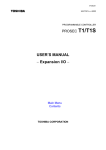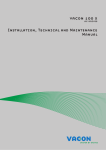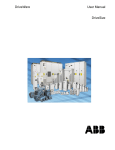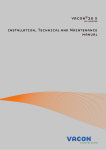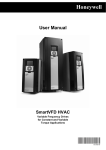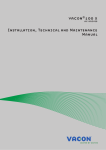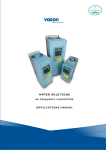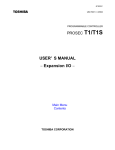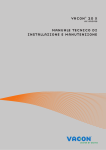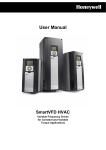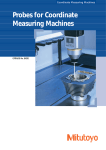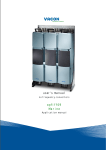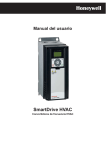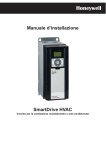Download vacon 20 Cold Plate installation manual
Transcript
vacon 20 Cold Plate ac drives installation manual vacon • 0 INDEX Document code: DPD00489D Order code: DOC-INS03976+DLUK Rev. D Revision release date: 25.11.11 1. Safety ............................................................................................................... 2 1.1 1.2 1.3 1.4 1.5 1.6 Danger ................................................................................................................................ 2 Warnings ............................................................................................................................ 3 Earthing and earth fault protection ................................................................................... 4 Insulation system ............................................................................................................... 6 Compatibility with RCDs..................................................................................................... 7 Cooling System................................................................................................................... 7 2. Receipt of delivery............................................................................................ 8 2.1 2.2 2.3 2.3.1 Type designation code........................................................................................................ 9 Unpacking and lifting the AC drive .................................................................................. 10 Accessories ...................................................................................................................... 10 ‘Product modified’ sticker................................................................................................ 10 3. Mounting......................................................................................................... 12 3.1 3.1.1 3.2 3.3 3.4 3.5 3.6 3.7 Dimensions....................................................................................................................... 12 Frame MS2 and MS3 ........................................................................................................ 12 Cooling.............................................................................................................................. 13 Environment temperature ............................................................................................... 13 Heat sink assembly instructions...................................................................................... 13 Installation spacing .......................................................................................................... 15 Power loss thermal characteristics ................................................................................ 16 Dimensioning an external heatsink ................................................................................. 17 4. Power cabling................................................................................................. 20 4.1 4.2 4.2.1 4.3 4.4 4.5 Circuit breaker ................................................................................................................. 21 UL standards on cabling .................................................................................................. 21 Cable dimensioning and selection................................................................................... 21 Brake resistor cables....................................................................................................... 22 Control cables .................................................................................................................. 22 Cable installation ............................................................................................................. 23 5. Control unit .................................................................................................... 26 5.1 5.1.1 5.1.2 5.1.3 5.1.4 5.1.5 5.1.6 5.1.7 5.2 5.2.1 5.2.2 Control unit cabling.......................................................................................................... 28 Control cable sizing.......................................................................................................... 28 Standard I/O terminals..................................................................................................... 29 Relay terminals ................................................................................................................ 30 Safe Torque off (STO) terminals ...................................................................................... 30 Description of additional echo connectors ...................................................................... 31 Led handling..................................................................................................................... 33 Selection of terminal functions with dip switches........................................................... 34 Fieldbus connection ......................................................................................................... 35 Modbus RTU protocol....................................................................................................... 36 Preparation for use through RS485................................................................................. 37 6. Commissioning ............................................................................................... 38 6.1 6.2 6.2.1 6.2.2 6.3 Commissioning of the drive ............................................................................................. 39 Changing EMC protection class....................................................................................... 40 Changing EMC protection class - MS2 ............................................................................ 40 Changing EMC protection class - MS3 ............................................................................ 42 Running the motor ........................................................................................................... 43 24-hour support +358 (0)201 212 575 • E-mail: [email protected] vacon • 1 6.3.1 Cable and motor insulation checks ................................................................................. 43 6.4 Maintenance ..................................................................................................................... 44 7. Technical data ................................................................................................ 46 7.1 7.1.1 7.1.2 7.2 7.3 7.3.1 AC drive power ratings..................................................................................................... 46 Mains voltage 380-480 V .................................................................................................. 46 Definitions of overloadability ........................................................................................... 46 Brake resistors ................................................................................................................ 47 Vacon 20 Cold Plate - technical data ............................................................................... 48 Technical information on control connections ................................................................ 51 8. Options ........................................................................................................... 54 8.1 8.2 8.3 8.4 8.4.1 8.4.2 8.4.3 8.4.4 8.4.5 8.5 Vacon keypad with seven-segment display ..................................................................... 54 Text keypad....................................................................................................................... 55 Menu structure................................................................................................................. 55 Using the keypad .............................................................................................................. 56 Editing values ................................................................................................................... 56 Resetting fault .................................................................................................................. 56 Local/Remote control button........................................................................................... 56 Parameters ...................................................................................................................... 57 Faults................................................................................................................................ 57 Fault tracing ..................................................................................................................... 58 9. Safe Torque Off............................................................................................... 60 9.1 9.2 9.3 9.4 9.4.1 9.5 9.5.1 9.5.2 9.6 9.6.1 9.6.2 9.7 9.8 General description.......................................................................................................... 61 Warnings .......................................................................................................................... 61 Standards ......................................................................................................................... 62 The principle of STO ......................................................................................................... 63 Technical details .............................................................................................................. 64 Connections...................................................................................................................... 65 Reduced Safety Capability................................................................................................ 66 Maximum Safety capability .............................................................................................. 67 Commissioning................................................................................................................. 69 General wiring instructions ............................................................................................. 69 Checklist for the commissioning ..................................................................................... 69 Parameters and fault tracing........................................................................................... 70 Maintenance and diagnostics .......................................................................................... 71 Tel. +39 0473 671911 • Fax +39 0471 671909 Safety 1. vacon • 2 SAFETY This manual contains clearly marked cautions and warnings which are intended for your personal safety and to avoid any unintentional damage to the product or connected appliances. Please read the information included in cautions and warnings carefully. The cautions and warnings are marked as follows: = DANGEROUS VOLTAGE! = WARNING or CAUTION Table 1. Warning signs 1.1 Danger The components of the power unit of Vacon 20 Cold Plate Drives are live when the drive is connected to mains potential. Coming into contact with this voltage is extremely dangerous and may cause death or severe injury. The motor terminals (U, V, W) are live when Vacon 20 Cold Plate Drive is connected to mains, even if the motor is not running. After disconnecting the AC drive from the mains, wait until the indicators on the keypad go out (if no keypad is attached, see the indicators on the cover). Wait additional 30 seconds before starting any work on the connections of Vacon20 Cold Plate Drive. After expiration of this time, use a measuring equipment to absolutely ensure that no voltage is present. Always ensure absence of voltage before starting any electrical work! The control I/O-terminals are isolated from the mains potential. However, the relay outputs and other I/O-terminals may have a dangerous control voltage present even when Vacon 20 Cold Plate Drive is disconnected from mains. During a coast stop (see the Application Manual), the motor is still generating voltage to the drive. Therefore, do not touch the components of the AC drive before the motor has completely stopped. Wait until the indicators on the keypad go out (if no keypad is attached, see the indicators on the cover). Wait additional 30 seconds before starting any work on the drive. 24-hour support +358 (0)201 212 575 • Email: [email protected] 1 vacon • 3 1.2 Safety Warnings Vacon 20 Cold Plate AC drive is meant for fixed installations only. Not every circuit can be connected to the unit. The standard requirements are fulfilled only if the external circuit fulfils the requirements of an (earthed) Extra Low Voltage circuit, otherwise the insulation system will be destroyed. This hint aims to protect both the drive and the customer-application. Vacon is not responsible for indirect or consequential damages resulting from unsafe connections of external circuits to the drive. See paragraph 1.4 Do not perform any measurements when the AC drive is connected to the mains. Do not perform any voltage withstand test on any part of Vacon 20 CP. The tests shall be performed according to a specific procedure. Ignoring this procedure may damage the product. Before performing any measurement on the motor or the motor cable, disconnect the motor cable from the AC drive. Do not touch the components on the circuit boards. Static voltage discharge may damage the components. If the AC drive is used as a part of a machine, the machine manufacturer is responsible for providing the machine with a supply disconnecting device (EN 60204-1). See paragraph 4.1 The touch current of Vacon 20 Cold Plate drives exceeds 3.5mA AC. According to standard EN61800-5-1, a reinforced protective ground connection must be ensured. See paragraph 1.3. Only spare parts supplied by Vacon can be used. At power-up, power brake or fault reset, the motor will start immediately if the start signal is active, unless the pulse control for Start/Stop logic has been selected. Furthermore, the I/O functionalities (including start inputs) may change if parameters, applications or software are changed. Disconnect, therefore, the motor if an unexpected start can cause danger. This is valid only if STO inputs are energized. For prevention on unexpected restart, use appropriate safety relay connected to the STO inputs. The motor starts automatically after automatic fault reset if the autoreset function is activated. See the Application Manual for more detailed information. This is valid only if STO inputs are energized. For prevention on unexpected restart, use appropriate safety relay connected to the STO inputs. Check that the EMC level of the AC drive corresponds to the requirements of your supply network. In a domestic environment, this product may cause radio interference, in which case supplementary mitigation measures may be required. 1 Tel. +39 0473 671911 • Fax +39 0473 671909 Safety 1.3 vacon • 4 Earthing and earth fault protection CAUTION! The Vacon 20 Cold Plate AC drive must always be earthed with an earthing conductor connected to the earthing terminal marked with . Since the touch current exceeds 3.5 mA AC, according to EN61800-5-1, the drive shall have a fixed connection and provision of an additional terminal for a second protective earthing conductor of the same cross-sectional area as the original protective earthing conductor. Three screws are provided for: the ORIGINAL protective earthing conductor, the SECOND protective conductor and the MOTOR protective conductor (the customer can choose the screw for each one). See Figure 1 for the location of the three screws in the two possible options available. Figure 1. Protective earthing connections. In Vacon 20 CP, the phase conductor and the corresponding protective earthing conductor can be of the same cross-sectional area, provided they are made of the same metal (because the cross-sectional area of the phase conductor is less than 16 mm2). 24-hour support +358 (0)201 212 575 • Email: [email protected] 1 vacon • 5 Safety The cross-sectional area of every protective earthing conductor which does not form a part of the supply cable or cable enclosure shall, in any case, be not less than: • • 2.5 mm2 if mechanical protection is provided or 4 mm2 if mechanical protection is not provided. For cord-connected equipment, provisions shall be made so that the protective earthing conductor in the cord shall, in the case of failure of the strain-relief mechanism, be the last conductor to be interrupted. However, always follow the local regulations for the minimum size of the protective earthing conductor. NOTE: Due to the high capacitive currents present in the AC drive, fault current protective switches may not function properly. 1 Tel. +39 0473 671911 • Fax +39 0473 671909 Safety 1.4 vacon • 6 Insulation system Please, consider carefully the insulation system depicted in Figure 2, before connecting any circuit to the unit. A distinction has to be made for the following three groups of terminals, according to the insulation system of Vacon 20 CP: • • • Mains and motor connections (L1, L2, L3, U, V, W) Relays (R01, R02) EARTHED Control terminals (I/Os, RS485, ...) The Control connections are isolated from the Mains (the insulation is reinforced, according to IEC 61800-5-1) and the GND terminals are permanently earthed (through an RC circuit). This is important when you need to connect other circuits to the drive and test the complete assembly. Should you have any doubts or questions, please contact your local Vacon distributor. KEYPAD 10 Vref GND +24V GND AI1+ AI1AI2+ AI2DI1.....DI6 CM AO1+ AO1- GND F CONTROL UNIT RS485 F RO1/1 RO1/2 R RO2/1 RO2/2 RO2/3 R L1 L2 L3 R POWER UNIT DC+ F Functional R Reinforced U V W R- DC-* Figure 2. Insulation system(* only for MS3). 24-hour support +358 (0)201 212 575 • Email: [email protected] 1 vacon • 7 1.5 Safety Compatibility with RCDs This product can cause a d.c. current in the protective earthing conductor. Where a residual current-operated protective (RCD) or monitoring (RCM) device is used for protection in case of direct or indirect contact, only an RCD or RCM of Type B is allowed on the supply side of this product. 1.6 Cooling System Vacon 20 CP is available as a cold-plate solution. Customers can enclose it in their own housing and provide a suitable heat-sink. However under maximum operating conditions the unit should not exceed the following temperatures: • • Temperature around the polymeric enclosure (of Vacon 20 CP): max. 70 °C Temperature at the cooling-plate (of Vacon 20 CP): max. 85 °C Please, contact your local Vacon distributor if you need further details or support to dimension the cooling system in your final application. 1 Tel. +39 0473 671911 • Fax +39 0473 671909 Receipt of delivery 2. vacon • 8 RECEIPT OF DELIVERY Check correctness of delivery by comparing your order data to the drive information found on the package label. If the delivery does not correspond to your order, contact your supplier immediately. See paragraph 2.3. Vacon type code AC DRIVE Type: VACON0020-3L-0006-4-CP Batch ID Serial number S/N: M100112345 B.ID: 122245 Code: 70SCO000293-BM1X IP class EMC level Rated current: 6A Rated voltage: 380-480 V Protection: IP00 EMC level: C2 Firmware: Rated current Supply voltage Application code FW0065V008 Application: Cust. Ord. No: Marks: Customer’s order number 3234500378 CUSTOMER NAME Figure 3. Vacon package label 24-hour support +358 (0)201 212 575 • Email: [email protected] 2 vacon • 9 2.1 Receipt of delivery Type designation code Vacon type designation code is formed of a nine-segment code and optional +codes. Each segment of the type designation code uniquely corresponds to the product and options you have ordered. The format of the code is as follows: VACON0020-3L-0009-4-CP +xxxx +yyyy VACON +xxxx +yyyy This segment is common for all products. Additional codes. 0020 Examples of additional codes: Product range: +DBIR 0020 = Vacon 20 Dynamic Brake Internal Resistance (optional) 3L Input/Function: 3L = Three-phase input 0009 Drive rating in ampere; e.g. 0009 = 9 A See Table 21 for all the drive ratings 4 Supply voltage: 4 = 380-480 V CP - Cold Plate 2 Tel. +39 0471 671911 • Fax +39 0471 671909 Receipt of delivery 2.2 vacon • 10 Unpacking and lifting the AC drive The weights of the AC drives vary according to frame size. Note the weights of each individual frame size in Table 2 below. Frame Weight [kg] MS2 2 MS3 3 Table 2. Frame weights Vacon 20 Cold Plate drives have undergone scrupulous tests and quality checks at the factory before they are delivered to the customer. However, after unpacking the product, check that no signs of transport damages are to be found on the product and that the delivery is complete. Should the drive have been damaged during the shipping, please contact primarily the cargo insurance company or the carrier. 2.3 Accessories After lifting the converter out, check that the delivery is complete and the following accessories are included: • • STO terminal connector (six pins black connector, see Figure 4) ‘Product modified’ sticker Figure 4. STO connector. 2.3.1 ‘Product modified’ sticker In the small plastic bag included in the delivery, you will find a silver Product modified sticker. The purpose of the sticker is to notify the service staff about the modifications made in the AC drive. Attach the sticker on the side of the AC drive to avoid losing it. Should the AC drive be later modified, mark the change on the sticker. Product modified Date: Date: Date: Figure 5. ‘Product modified’ sticker 24-hour support +358 (0)201 212 575 • Email: [email protected] 2 vacon • 11 2 Receipt of delivery Tel. +39 0471 671911 • Fax +39 0471 671909 Mounting 3. vacon • 12 MOUNTING The AC drive has to be mounted on the wall or on the back plane of a cubicle. Ensure that the mounting plane is relatively even. Frame size MS2 can be mounted in any position, while frame size MS3 can be mounted only in vertical position. The drive shall be fixed with two screws (or bolts, depending on the unit size). 3.1 Dimensions 3.1.1 Frame MS2 and MS3 Figure 6. Vacon 20 Cold Plate, MS2. Figure 7. Vacon 20 Cold Plate, MS3. The correct mounting position (only vertical). 24-hour support +358 (0)201 212 575 • Email: [email protected] 3 vacon • 13 3.2 Mounting Cooling The AC drive produces heat in operation due to the energy dissipation of the electronic components (rectifier and IGBT) and is cooled down by a heat sink via the cold plate of the frequency converter. The capacity to dissipate this heat mainly depends on the size of the heat sink surface, the environment temperature and the heat transmission resistance. An increase of the heat transmission rate can only be realized to a certain extent by increasing the surface of the heat sink. An additional increase of the heat dissipation by increasing the heat sink is not possible. The frequency converter should be mounted with the cold plate on a heat sink with lowest thermal resistance possible. 3.3 Environment temperature The drive environment temperature shall not exceed 70 °C (158 °F) for the drive installed location. The aluminium panel of the back of the drive is called “cold plate”. The cold plate should never exceed 85 °C (185 °F). The drive may be damaged if the temperature of the cooling plate exceeds specified tolerance level. Excessive heat can also shorten the performance life of the various AC drive components. 3.4 Heat sink assembly instructions The Vacon 20 Cold Plate frequency converters are designed for installation on surfaces which comply with the specifications listed in the present paragraph. Heat sink surface that is in contact with the frequency converter cold plate must be free from dirt and particles. The mating surface flatness shall not exceed 50m (DIN EN ISO 1101) across the entire mating surface, and the roughness less than 6.3 m(DIN EN ISO 4287). The maximum peak-valley height of the surface shall not exceed 10 m (DIN EN ISO 4287). Apply a thermal compound between the heat sink and the AC drive cooling mating surface. The thermal paste assists the drive heat dissipation. Vacon recommends the thermal compounds listed in the following table: Table 3. Recommended cold plate thermal compound. Manufacturer Type Model Wacker Chemie Silicon paste for heat dissipation P 12 Fischer Elektronik WLPF Silicon paste for heat dissipation WLPF Recommended spread amount 100 m Apply the coating evenly across the surface Vacon recommends screen printing for applying the thermal paste. In certain cases an applying by hard rubber roller might be applicable. After mounting the AC drive to the heat sink panel, wipe away any excess compound from around the plate. 3 Tel. +39 0473 671911 • Fax +39 0473 671909 Mounting vacon • 14 Place the Vacon 20 Cold plate on the appropriate heat sink area and tighten the screws as listed in the following table: Table 4. Screw size and tightening torque. Frame size Screw size Tightening torque N•m (lb•in) MS2 M5 (according to DIN 7985 - 8.8 (with washer)) 3.0 to 3.5 Nm (0.34 to 0.39lb•in) MS3 M5 (according to DIN 7985 - 8.8 (with washer)) 3.0 to 3.5 Nm (0.34 to 0.39lb•in) Tighten all screws according to specified torques. Failure to do so, may inhibit drive cooling and cause possible damage to the drive. Figure 8. Heat sink plate for MS2(bottom view).The thickness of the plate is 6.0 mm. 24-hour support +358 (0)201 212 575 • Email: [email protected] 3 vacon • 15 Mounting Figure 9. Heat sink plate for MS3(bottom view).The thickness of the plate is 9.5 mm. 3.5 Installation spacing Enough free space shall therefore be left around the AC drive to ensure sufficient air circulation and cooling. Different acts of maintenance may also require certain amount of free space. The minimum clearances given in Table 5 must be respected. It is also important to ensure that the temperature of the cooling air does not exceed the maximum environment temperature of the converter. Contact our factory for more information on required clearances in different installations. Min clearance [mm] B Type A B C All types 30 30 30 Table 5. Min. clearances around AC drive A A A A = Clearance left and right from the drive B = Clearance above the drive C = Clearance underneath the AC drive C Figure 10. Installation space 3 Tel. +39 0473 671911 • Fax +39 0473 671909 Mounting 3.6 vacon • 16 Power loss thermal characteristics In the table below there are the thermal characteristics of Vacon 20 CP AC drive at nominal output current (400V, cosfi 0.85, switching frequency 6 kHz). The power loss in stand-by conditions is 12 W for all sizes (supply voltage 24 V, 100 mA). Table 6. Drive power loss at rated conditions. Frame MS2 MS3 Converter Rated output Type current [A] Cold plate loss [W] Internal loss [W] Total loss [W] 0003 2.4 23 16 39 0004 3.3 31 18 49 0005 4.3 43 21 64 0006 5.6 58 25 83 0008 7.6 84 33 117 0009 9.0 86 31 117 0012 12.0 120 37 157 0016 16.0 171 48 219 24-hour support +358 (0)201 212 575 • Email: [email protected] 3 vacon • 17 3.7 Mounting Dimensioning an external heatsink This paragraph describes a useful procedure to select a suitable heatsink for Vacon 20 Cold Plate drives. The heatsinks are devices that enhance heat dissipation from a hot surface, usually the case of a heat generating component, to a cooler ambient, usually air. For the following discussion, air is assumed to be the cooling fluid. The primary purpose of a heatsink is to maintain the device temperature below the maximum allowable specified by the device manufacturers. Before discussing the heatsink selection process, it’s necessary to define common terms, notations and definitions and establish the concept of a thermal circuit. Notations and definitions of the terms are as follows: Table 7. Terms and definitions for the thermal model. Symbol Description CPloss Cold plate loss: see Table 6 expressed in W TCPmax Maximum heatsink temperature expressed in °K (358 °K = 85°C) Tamb Heat sink ambient temperature expressed in °K(°K = °C + 273) Thermal resistance [K/W] of the junction between the cold plate and the external heatsink. It can be calculated by: d comp 1 R J = -------------- -------------- comp A comp RJ where: comp is the thermal conductivity of the compound [W/(mK)] dcomp is the thickness of the thermal compound [m] Acomp is the contact area between the cold plate and the heatsink [m2] RHS Thermal resistance of the heatsink [K/W] The purpose of this paragraph is to select an external heatsink by calculating its thermal resistance. The heat transfer principle from the cold plate to the heatsink ambient air is shown in Figure 10. 3 Tel. +39 0473 671911 • Fax +39 0473 671909 Mounting vacon • 18 TEnclosure CPloss TCP RJ RHS TCP Tamb Tamb Figure 11.Thermal equivalent circuit. The formula to calculate the maximum thermal resistance of the heatsink is as follow: T CPmax – T amb R HS max = ------------------------------------- – R J P loss For a given ambient temperature Tamb the cold plate temperature TCPmax must not exceed the maximum allowable value (85°C). As the RJ is essentially fixed, this condition must be satisfied with a proper heatsink selection. The table below shows the typical values for RJ for Vacon 20 CP: Table 8. Typical values for the junction thermal resistances. Frame RJ J = 1 W/mK thermal conductivity of the thermal compound WLPF MS2 dJ = 100 m recommended thickness of thermal compound AJ= 0,00704 m2 RJ=0.014 K/W J = 1 W/mK thermal conductivity of the thermal compound WLPF MS3 dJ= 100 m recommended thickness of thermal compound AJ= 0,0145 m2 RJ= 0,0068 K/W 24-hour support +358 (0)201 212 575 • Email: [email protected] 3 vacon • 19 Mounting Select a heatsink with a smaller thermal resistance than RHSmax. The heatsink dimensions should be closed to the cold plate dimensions. If the heatsink height and width are much larger than the drive cold plate dimensions, or if multiple drives are installed on one heatsink, it may be necessary to apply correction factors to the thermal resistance value given in the heatsink specification. Contact the heatsink manufacturer. Note: remember that the heatsink cooling capacity can be reduced over time due to dirt. 3 Tel. +39 0473 671911 • Fax +39 0473 671909 Power cabling 4. vacon • 20 POWER CABLING The mains cables are connected to terminals L1, L2 and L3 and the motor cables to terminals marked with U, V and W. See principal connection diagram in Figure 12. See also Table 9 for the cable recommendations for different EMC levels. Keypad Control L1 U/T1 Power unit L3 W/T3 R- M DC-(*) V/T2 DC+ L2 Figure 12. Principal connection diagram(* only MS3). Use cables with heat resistance in accordance with the application requirements. The cables and the fuses must be dimensioned according to the AC drive nominal OUTPUT current which you can find on the rating plate. Table 9. Cable types required to meet standards EMC levels 1st environment 2nd environment Cable type Category C2 Category C3 Category C4 Mains cable 1 1 1 Motor cable 3* 2 2 Control cable 4 4 4 1 = Power cable intended for fixed installation and the specific mains voltage. Shielded cable not required. (MCMK or similar recommended). 2 = Symmetrical power cable equipped with concentric protection wire and intended for the specific mains voltage. (MCMK or similar recommended). See Figure 13. 3 = Symmetrical power cable equipped with compact low-impedance shield and intended for the specific mains voltage. [MCCMK, EMCMK or similar recommended; Recommended cable transfer impedance (1...30MHz) max. 100mohm/m]. See Figure 13. *360º earthing of the shield with cable glands in motor end needed for EMC category C2. 4 = Screened cable equipped with compact low-impedance shield (JAMAK, SAB/ÖZCuY-O or similar). 24-hour support +358 (0)201 212 575 • Email: [email protected] 4 vacon • 21 Power cabling PE conductors Shield Shield PE conductor Figure 13. NOTE: The EMC requirements are fulfilled at factory defaults of switching frequencies (all frames). NOTE: If safety switch is connected the EMC protection shall be continuous over the whole cable installation. 4.1 Circuit breaker Please, disconnect the drive via an external circuit breaker. You have to provide a switching device between Mains and supply with the following characteristics: • • Output power <= 2,2 kW: 20 Arms / Type B or C Output power = 3 kW: 25 Arms / Type B or C 4.2 UL standards on cabling To meet the UL (Underwriters Laboratories) regulations, use a UL-approved copper cable. Use Class 1 wire only. The units are suitable for use on a circuit capable of delivering no more than 100,000 rms symmetrical amperes, 600V AC maximum. 4.2.1 Cable dimensioning and selection Table 10 shows the minimum dimensions of the Cu/Al-cables and the corresponding fuse sizes. These instructions apply only to cases with one motor and one cable connection from the AC drive to the motor. In any other case, ask the factory for more information. 4 Tel. +39 0473 671911 • Fax +39 0473 671909 Power cabling 4.2.1.1 vacon • 22 Cable and fuse sizes, frames MS2 to MS3 The recommended fuse types are gG/gL (IEC 60269-1) or class T (UL & CSA). The fuse voltage rating should be selected according to the supply network. The final selection should be made according to local regulations, cable installation conditions and cable specifications. Bigger fuses than what is recommended below shall not be used. Check that the fuse operating time is less than 0.4 seconds. Operating time depends on used fuse type and impedance of the supply circuit. Consult the factory about faster fuses. Vacon offers recommendations also for high speed J (UL & CSA ), aR (UL recognized, IEC 60269-4) and gS (IEC 60269-4) fuse ranges. Terminal cable size Frame MS2 MS3 Type IINPUT [A] Fuse (gG/gL) [A] Mains and motor cable Cu [mm2] Main terminal [mm2] Earth terminal [mm2] 0003 4—0004 4 3.2—4.0 6 3*1.5+1.5 0.2 — 2.5 ring terminal 0005 4—0006 4 5.6—7.3 10 3*1.5+1.5 0.2 — 2.5 ring terminal 0008 4 9.6 20 3*2.5+2.5 0.2 — 2.5 ring terminal 0009 4 11.4 20 3*2.5+2.5 0.5 — 16.0 ring terminal 0012 4 14.4 20 3*2.5+2.5 0.5 — 16.0 ring terminal 0016 4 20 25 3*6+6 0.5 — 16.0 ring terminal Table 10. Cable and fuse sizes for Vacon 20 CP (MS2 and MS3) The cable dimensioning is based on the criteria of the International Standard IEC60364-5-52: Cables must be PVC-isolated; use only cables with concentric copper shield; Max number of parallel cables is 9. When using cables in parallel, NOTE HOWEVER that the requirements of both the cross-sectional area and the max number of cables must be observed. For important information on the requirements of the earthing conductor, see chapter Earthing and earth fault protection of the standard. For the correction factors for each temperature, see International Standard IEC60364-5-52. 4.3 Brake resistor cables Vacon 20 Cold Plate AC drives are equipped with terminals for an optional external brake resistor. These terminals have to be 6.3 mm Faston for MS2. See Table 22 for the resistor ratings. 4.4 Control cables For information on control cables see chapter Control unit cabling. 24-hour support +358 (0)201 212 575 • Email: [email protected] 4 vacon • 23 4.5 • • • • • • • • Power cabling Cable installation Before starting, check that none of the components of the AC drive is live. Read the warnings in chapter 1 carefully Place the motor cables sufficiently far from other cables Avoid placing the motor cables in long parallel lines with other cables. If the motor cables run in parallel with other cables note the minimum distances between the motor cables and other cables given in table below. Distance between cables, [m] Shielded cable, [m] 0.3 50 1.0 200 The given distances also apply between the motor cables and signal cables of other systems. The maximum length for motor cables is 30m The motor cables should cross other cables at an angle of 90 degrees. If cable insulation checks are needed, see chapter Cable and motor insulation checks. Start the cable installation according to the instructions below: 1 Strip the motor and mains cables as below recommended. Earth conductor Earth conductor A1 C1 B1 D1 C2 Shield D2 E MAINS MOTOR Figure 14. Stripping of cables Frame A1 B1 C1 D1 C2 D2 E MS2 8 8 8 20 36 20 MS3 8 8 8 20 36 20 Leave as short as possible Table 11. Cables stripping lengths [mm] 4 Tel. +39 0473 671911 • Fax +39 0473 671909 Power cabling 2 vacon • 24 Connect the stripped cables: • Expose the shield of all two cables in order to make a 360-degree connection with the cable clamp. • Connect the phase conductors of the supply and motor cables into their respective terminals. • Form the rest of the cable shield of all two cables into “pigtails” and make a grounding connection with the clamp. Make the pigtails just long enough to reach and be fixed to the terminal - no longer. Tightening torques of cable terminals: Frame Type Tightening torque [Nm]/[lb-in.] Power and motor terminals [Nm] lb-in. 4.5—5.3 Tightening torque [Nm]/[lb-in.] EMC grounding clamps [Nm] Tightening torque, [Nm]/[lb-in.] Grounding terminals lb-in. [Nm] lb-in. MS2 0003 4—0008 4 0.5—0.6 1.5 13.3 2.0 17.7 MS3 0009 4—0016 4 1.2—1.5 10.6—13.3 1.5 13.3 2.0 17.7 Table 12. Tightening torques of terminals 24-hour support +358 (0)201 212 575 • Email: [email protected] 4 vacon • 25 4 Power cabling Tel. +39 0473 671911 • Fax +39 0473 671909 Control unit 5. vacon • 26 CONTROL UNIT The control unit of the AC drive consists of the control board and additional boards (option boards) connected to the slot connectors of the control board. The locations of boards, terminals and switches are presented in Figure 15 and Figure 16. Table 13. Locations of components in control unit Number Meaning 1 Control terminals A-20 2 STO terminals 3 Relay terminals 4 Option board terminals 5 STO Jumpers 6 DIP switches 7 Status LEDs 8 HMI connector (RJ45 keypad connector) 9 Optional brake resistor terminals 10 Supply voltage connector for external fan 11 Control terminals A-20 remote connector 12 HMI remote connector (keypad connector) Figure 15. Locations of the components in control unit of MS2. 24-hour support +358 (0)201 212 575 • Email: [email protected] 5 vacon • 27 Control unit Figure 16. Location of the components in the control unit of MS3. When delivered from the factory, the control unit of the AC drive contains the standard controlling interface - the control terminals of the control board and the relay board - unless otherwise specifically ordered. In the following pages you will find the arrangement of the control I/ O and the relay terminals, the general wiring diagram and the control signal descriptions. The control board can be powered externally (+24VDC ±10%, 100mA) by connecting the external power source between terminal #6 and GND, see chapter 5.1.2. This voltage is sufficient for parameter setting and for keeping the control unit active. Note however that the values of the measurements of the main circuit (e.g. DC-link voltage, unit temperature) are not available when the mains is not connected. 5 Tel. +39 0473 671911 • Fax +39 0473 671909 Control unit 5.1 vacon • 28 Control unit cabling The principal terminal block placement is shown in Figure 17 below. The control board is equipped with 18 fixed control I/O terminals and the relay board with 5. Additionally, the terminals for the Safe Torque Off (STO) function (see chapter 9) can be seen in the picture below. All signal descriptions are given in Table 15 too. Figure 17. Control terminals 5.1.1 Control cable sizing The control cables shall be at least 0.14 mm2 screened multi core cables, see Table 9. The maximum terminal wire size for the I/O terminals is 1.5 mm2. Find the tightening torques of the I/O (control and relays) and STO terminals in the Table below. Table 14. Control cable tightening torques Tightening torque Terminal screw Nm I/O terminals and STO terminals (screw M2) 0.22 min 0.25 max 24-hour support +358 (0)201 212 575 • Email: [email protected] lb-in. 1.94 min 2.21 max 5 vacon • 29 5.1.2 Control unit Standard I/O terminals The terminals of the Standard I/O board and the Relay boards are described below. For more information on connections, see chapter 7.3.1. The terminals shown on shadowed background are assigned for signals with optional functions selectable with DIP switches. For more information, see chapter 5.1.7. Table 15. Control I/O terminal signals on standard I/O board and connection example Standard I/O board Terminal Reference potentiometer 1...10k Remote reference 4...20mA/0...10V V Signal A RS485_A Serial bus, negative B RS485_B Serial bus, positive 1 +10 Vref Reference output 2 AI1+ Analogue input, voltage or current 3 GND I/O signal ground 6 24Vout 24V aux. voltage 7 DIN COM Digital inputs common 8 DI1 Digital input 1 9 DI2 Digital input 2 10 DI3 Digital input 3 4 AI2+ Analogue input, voltage or current 5 GND I/O signal ground 13 DO1- Digital output 1 common 14 DI4 Digital input 4 15 DI5 Digital input 5 16 DI6 Digital input 6 18 AO1+ Analogue signal (+output) 20 DO1+ Digital output 1 X1 5 Tel. +39 0473 671911 • Fax +39 0473 671909 Control unit 5.1.3 vacon • 30 Relay terminals Table 16. I/O terminal signals for relay and connection example Relay board Terminal From standard I/O board From term. #6 From term. #7 RUN 5.1.4 22 RO1/2 23 RO1/3 24 RO2/1 25 RO2/2 26 RO2/3 Signal Relay output 1 Relay output 2 Safe Torque off (STO) terminals For more information on the functionalities of the Safe Torque Off (STO), see chapter chapter 9.. Table 17. I/O terminal signals for the STO functions Safe Torque Off terminals Terminal S1 G1 S2 G2 24-hour support +358 (0)201 212 575 • Email: [email protected] Signal Isolated digital input 1 (interchangeable polarity); +24V ±20% 10...15mA Isolated digital input 2 (interchangeable polarity); +24V ±20% 10...15mA F+ Isolated feedback (CAUTION! Polarity to be respected); +24V ±20% F- Isolated feedback (CAUTION! Polarity to be respected); +24V ±20% 5 vacon • 31 5.1.5 Control unit Description of additional echo connectors In this paragraph you will find the description of the additional echo connectors for the I/O terminals and for the HMI. 1 3 5 7 2 4 6 9 11 13 15 17 19 8 10 12 14 16 18 20 Figure 18. The I/O remote echo connector. In Figure 18 the view of Molex connector for the I/O terminals is shown. In the control box the position of this connector is numbered with 11 as shown in Figure 15 and Figure 16. The type of connector is Pico-clasp, Vertical, Dual Row SMD Header. The code by Molex is: 501571-2007. In the following table, the correspondence between the pins of this connector and the Vacon 20 CP terminals is shown. Table 18. I/O remote connector description. 5 Pin number Signal Description 1 DI2 Digital input 2 2 RS485_B Serial bus, negative 3 DI3 Digital input 3 4 RS485_A Serial bus, positive 5 AI2+ 6 - 7 GND 8 - not connected 9 DO1- common for digital output 1 10 +10Vref 11 DI4 12 AI1+ 13 DI5 14 GND 15 DI6 not connected Digital input 4 Digital input 5 Digital input 6 Tel. +39 0473 671911 • Fax +39 0473 671909 Control unit vacon • 32 Table 18. I/O remote connector description. Pin number Signal 16 24Vout 17 AO1+ 18 DIN COM 19 DO1+ Digital output 1 20 DI1 Digital input 1 1 2 3 4 5 6 7 Description Analogue output 1 8 9 10 11 12 13 14 15 Figure 19. HMI remote connector. In Figure 19 the view of Molex connector for the HMI terminals is shown. In the control box the position of this connector is numbered with 8, as shown in Figure 15 and Figure 16. The type of connector is Pico-clasp, Vertical, single Row SMD Header. The code by Molex is: 501331-1507. In the following table, the correspondence between the pins of this connector and the Vacon 20 CP HMI terminals is shown. Table 19. HMI remote connector description with RJ45 correspondences. Pin number in RJ45 connector Pin number of echo connector Signal Description 2 1 +24V Panel supply 6 2 +3.3V Panel supply 5 3 GND ground 1 4 Keyp_TX+ 4 5 Keyp_TX- 3 6 Keyp_RX+ 7 7 Keyp_RX- 8 8 Led_CTRL1 24-hour support +358 (0)201 212 575 • Email: [email protected] RS422 (connection for panel communication) Control signal for LED1 5 vacon • 33 Control unit Table 19. HMI remote connector description with RJ45 correspondences. Pin number in RJ45 connector Pin number of echo connector Signal Description - 9 Led_CTRL2 Control signal for LED2 - 10 Led_CTRL3 Control signal for LED3 - 11 FAN+ External FAN+(+24V) - 12 FAN- GND for external FAN - 13 nc not connected - 14 nc not connected - 15 nc not connected 5.1.6 Led handling As Vacon 20 Cold plate is often without the panel, on the plastic cover of the drive there are 4 status LEDs. See the picture below. Figure 20. LED position on the MS2 cover. Led “PWR” (orange led) means the drive is supplied by mains. Led “RUN” (green led) means the drive is running. Led “FLT” (red led) means the drive is in fault. Led “RDY” (orange led) means the drive is ready and no fault is present. When a Warning is active, the led starts blinking. 5 Tel. +39 0473 671911 • Fax +39 0473 671909 Control unit 5.1.7 vacon • 34 Selection of terminal functions with dip switches The Vacon 20 Cold Plate drive embodies four so-called switches that allow for two functional selections each. The shadowed terminals in Table 15 can be functionally modified with the dip switches. The switches have two positions: 0 and 1. See Figure 21 to locate the switches and make appropriate selections for your requirements. Figure 21. Dip switches 5.1.7.1 Switch SW1 The digital inputs (terminals 8-10 and 14-16) on the standard I/O board can be isolated from ground by setting the dip switch SW1 to position ‘1’. See Figure 21. Locate the switch and set it in the desired position. The switch in the position “0” means that the common of digital input must be connected to the ground. 5.1.7.2 Switches SW2 and SW3 Analogue inputs can be used as either current inputs or voltage inputs. The signal type is selected with two switches on the control board. The switch SW2 is related to analogue input AI1. In position “1” the analogue input AI1 works in voltage mode. In position “0” the analogue input works in current mode. The voltage range is 0...10V and the current is 0/4.....20 mA. The switch SW3 is related to analogue input AI2. In the position “1” the analogue input AI2 works in voltage mode. In the position “0” the analogue input works in current mode. The voltage range is 0...10V and the current is 0/4.....20 mA. 5.1.7.3 Switch SW4 The switch SW4 is related to the RS485 connection. It’s used for bus termination. The bus termination must be set to the first and to the last device on the network. The switch SW4 in position “0” means that termination resistance is connected and the termination of the bus has been set. If the Vacon 20 CP is the last device on the net, this switch must be set to “0” position. 24-hour support +358 (0)201 212 575 • Email: [email protected] 5 vacon • 35 5.2 Control unit Fieldbus connection Modbus is a communication protocol developed by Modicon systems. In other words, it is a way of sending information between electronic devices. The device requesting the information is called the Modbus Master and the devices supplying information are Modbus Slaves. In a standard Modbus network, there is one Master and up to 247 Slaves, each with a unique Slave Address from 1 to 247. The Master can also write information to the Slaves. Modbus is typically used to transmit signals from instrumentation and control devices back to a main controller or data gathering system. The Modbus communication interface is built around messages. The format of these Modbus messages is independent of the type of physical interface used. The same protocol can be used regardless of the connection type. Thanks to this, Modbus gives the possibility to easily upgrade the hardware structure of an industrial network, without the need for large changes in the software. A device can also communicate with several Modbus nodes at once, although they are connected with different interface types, with no need to use a different protocol for every connection. Figure 22.Basic structure of Modbus frame. On simple interfaces such as RS485, the Modbus messages are sent in plain form over the network. In this case the network is dedicated to Modbus. Each Modbus message has the same structure. Four basic elements are present in each message. The sequence of these elements is the same for all messages, to make it easy to parse the content of the Modbus message. A conversation is always started by a master in the Modbus network. A Modbus master sends a message and—depending of the contents of the message— a slave takes action and responds to it. There can be more masters in a Modbus network. Addressing in the message header is used to define which device should respond to a message. All other nodes on the Modbus network ignore the message if the address field doesn't match their own address. 5 Tel. +39 0473 671911 • Fax +39 0473 671909 Control unit 5.2.1 vacon • 36 Modbus RTU protocol Table 20. Connections and communications Interface RS-485 Data transfer method RS-485 MS/TP, half-duplex Transfer cable STP (shielded twisted pair), type Belden 9841 or similar Connector 2.5 mm2 Electrical isolation Functional Modbus RTU As described in “Modicon Modbus Protocol Reference Guide” Baud rate 300, 600, 1200, 2400, 4800, 9600, 19200, 38400 and 57600 baud Addresses 1 to 247 Vacon 20 CP drive is equipped with Modbus support as standard. The AC drive can be connected to fieldbus through RS485. The connection for RS485 is on the standard I/O (terminals A and B). See Figure 23. Figure 23. Position of the RS485 terminals on the I/O standard terminal connector. 24-hour support +358 (0)201 212 575 • Email: [email protected] 5 vacon • 37 5.2.2 Control unit Preparation for use through RS485 Strip about 15 mm of the RS485 cable (see specification on Table 20) and cut off the grey cable shield. Remember to do this for both bus cables (except for the last device). Leave no more than 10 mm of the cable outside the terminal block and strip the cables at about 5 mm to fit in the terminals. See picture below. 10 5 1 Also strip the cable now at such a distance from the terminal that you can fix it to the frame with the grounding clamp. Strip the cable at a maximum length of 15 mm. Do not strip the aluminium cable shield! 2 3 Then connect the cable to its appropriate terminals on Vacon20 Cold Plate AC drive standard terminal block, terminals A and B (A = negative, B = positive). Using the cable clamp included in the supply of the drive, ground the shield of the RS485 cable to the frame of the AC drive. If Vacon 20 Cold Plate drive is the last device on the bus, the bus termination must be set. Locate the switches to the right of the control terminals (see Figure 21) and turn the SW4 switch to position “1”. Biasing is built in the termination resistor. 4 5 6 5 NOTE: When planning the cable runs, remember to keep the distance between the fieldbus cable and the motor cable at a minimum of 30 cm. The bus termination must be set for the first and the last device of the fieldbus line. We recommend that the first device on the bus and, thus, terminated, was the Master device. Tel. +39 0473 671911 • Fax +39 0473 671909 Commissioning 6. vacon • 38 COMMISSIONING Before commissioning, note the following directions and warnings: Internal components and circuit boards of Vacon 20 Cold Plate drive (except for the galvanically isolated I/O terminals) are live when it is connected to mains potential. Coming into contact with this voltage is extremely dangerous and may cause death or severe injury. The motor terminals U, V, W and the brake resistor terminals are live when Vacon 20 Cold Plate drive is connected to mains, even if the motor is not running. The control I/O-terminals are isolated from the mains potential. However, the relay outputs and other I/O-terminals may have a dangerous control voltage present even when Vacon 20 Cold Plate drive is disconnected from mains. Do not make any connections to or from the frequency converter when it is connected to the mains. After disconnecting the AC drive from the mains, wait until the indicators on the powerhead go out. Wait additional 30 seconds before doing any work on the connections of Vacon20 Cold Plate Drive. Do not open the unit before this time has expired. After expiration of this time, use a measuring equipment to absolutely ensure that no voltage is present. Always ensure absence of voltage before starting any electrical work! 24-hour support +358 (0)201 212 575 • Email: [email protected] 6 vacon • 39 6.1 Commissioning Commissioning of the drive Read carefully the safety instructions in Chapter 1 and above and follow them. After the installation: Check that both the frequency converter and the motor are grounded. Check that the mains and motor cables comply with the requirements given in chapter 4.1.1. Check that the control cables are located as far as possible from the power cables, see chapter 4.4. Check that the shields of the shielded cables are connected to protective earth marked with . Check the tightening torques of all terminals Check that the wires do not touch the electrical components of the drive. Check that the common inputs of digital input groups are connected to +24V or ground of the I/O terminal Check the quality and quantity of cooling air Check the inside of the frequency converter for condensation. Check that all Start/Stop switches connected to the I/O terminals are in Stop-position. Before connecting the frequency converter to mains: Check mounting and condition of all fuses and other protective devices. Run the Startup Wizard (see the Application Manual). 6 Tel. +39 0473 671911 • Fax +39 0473 671909 Commissioning 6.2 vacon • 40 Changing EMC protection class If your supply network is an IT (impedance-grounded) system but your AC drive is EMC-protected according to class C2 you need to modify the EMC protection of the AC drive to EMClevel T. This is done as described below: Warning! Do not perform any modifications on the AC drive when it is connected to mains. 6.2.1 1 Changing EMC protection class - MS2 Remove the three screws on the EMC plate from the unit. Figure 24.Changing of the EMC class in MS2 24-hour support +358 (0)201 212 575 • Email: [email protected] 6 vacon • 41 2 Commissioning Remove the EMC plate from the unit. Then turn up the lamella with pliers to disconnect the EMC plate from the ground. See Figure 25. Then reconnect the EMC plate to the unit. Figure 25. Changing of the EMC class in MS2 6 Tel. +39 0473 671911 • Fax +39 0473 671909 Commissioning 6.2.2 1 vacon • 42 Changing EMC protection class - MS3 Remove the EMC screw as shown in the Figure 26. Figure 26. Changing the EMC class in the MS3. CAUTION! Before connecting the AC drive to mains make sure that the EMC protection class settings of the drive are appropriately made. NOTE! After having performed the change write ‘EMC level modified’ on the sticker included in the Vacon 20 Cold Plate delivery (see below) and note the date. Unless already done, attach the sticker close to the name plate of the AC drive. Product modified Date: EMC-level modified C1->C4 24-hour support +358 (0)201 212 575 • Email: [email protected] Date: Date:DDMMYY 6 vacon • 43 6.3 Commissioning Running the motor MOTOR RUN CHECK LIST Before starting the motor, check that the motor is mounted properly and ensure that the machine connected to the motor allows the motor to be started. Set the maximum motor speed (frequency) according to the motor and the machine connected to it. Before reversing the motor make sure that this can be done safely. Make sure that no power correction capacitors are connected to the motor cable. Make sure that the motor terminals are not connected to mains potential. 6.3.1 6 Cable and motor insulation checks 1. Motor cable insulation checks Disconnect the motor cable from terminals U, V and W of the AC drive and from the motor. Measure the insulation resistance of the motor cable between each phase conductor as well as between each phase conductor and the protective ground conductor. The insulation resistance must be >1M at ambient temperature of 20°C. 2. Mains cable insulation checks Disconnect the mains cable from terminals L1, L2 and L3 of the AC drive and from the mains. Measure the insulation resistance of the mains cable between each phase conductor as well as between each phase conductor and the protective ground conductor. The insulation resistance must be >1Mat ambient temperature of 20°C 3. Motor insulation checks Disconnect the motor cable from the motor and open the bridging connections in the motor connection box. Measure the insulation resistance of each motor winding. The measurement voltage must equal at least the motor nominal voltage but not exceed 1000 V. The insulation resistance must be >1M at ambient temperature of 20°C. Tel. +39 0473 671911 • Fax +39 0473 671909 Commissioning 6.4 vacon • 44 Maintenance In normal conditions, the AC drive is maintenance-free. However, regular maintenance is recommended to ensure a trouble-free operation and a long lifetime of the drive. We recommend to follow the table below for maintenance intervals. Maintenance interval Regularly and according to general maintenance interval 6...24 months (depending on environment) Maintenance action • Check tightening torques of terminals • Check input and output terminals and control I/O terminals. Check for corrosion on terminals and other surfaces Check door filter in case of cabinet installation • • 24 month • Clean heatsink 24-hour support +358 (0)201 212 575 • Email: [email protected] 6 vacon • 45 6 Commissioning Tel. +39 0473 671911 • Fax +39 0473 671909 Technical data vacon • 46 7. TECHNICAL DATA 7.1 AC drive power ratings 7.1.1 Mains voltage 380-480 V Mains voltage 380-480V, 50-60 Hz, 3~ Loadability MS3 MS2 Converter type Rated continuous 50% overload current IN [A] current [A] Max current IS 0003 2.4 3.6 0004 3.3 0005 Nominal Motor shaft power input current [A} [kW] [HP] 4.8 3.2 0.75 1.0 5.0 6.6 4.0 1.1 1.5 4.3 6.5 8.6 5.6 1.5 2.0 0006 5.6 8.4 11.2 7.3 2.2 3.0 0008 7.6 11.4 15.2 9.6 3.0 5.0 0009 9.0 13.5 18.0 11.5 4.0 5.0 0012 12.0 18.0 24.0 14.9 5.5 7.5 0016 16.0 24.0 32.0 18.0 7.5 10.0 Table 21. Power ratings of Vacon 20 Cold Plate, supply voltage 400-480V. NOTE: The rated currents in given ambient temperatures (in Table 21) are achieved only when the switching frequency is equal to or less than the factory default. 7.1.2 Definitions of overloadability Overload ability =Following continuous operation at rated output current IN, the converter supplies 150% * IN for 1 min, followed by a period of at least 9 min at IN or below. Example: If the duty cycle requires 150% rated current for 1 min in every 10 min, the remaining 9 min must be at rated current IN or less. Current I N*150% I I N*150% N 1 min 9 min Time Figure 27. High overload 24-hour support +358 (0)201 212 575 • Email: [email protected] 7 vacon • 47 7.2 Technical data Brake resistors Table 22. Brake resistor ratings. Mains Voltage 380-480 V AC. 50/60 Hz Frame MS2 MS3 7 Type Minimum Resistance recommended [Ohm] Minimum Resistance calculated [Ohm] 0003 100 50 0004 100 50 0005 100 50 0006 100 50 0008 100 50 0009 50 23.08 0012 50 23.08 0016 50 23.08 Tel. +39 0473 671911 • Fax +39 0473 671909 Technical data 7.3 vacon • 48 Vacon 20 Cold Plate - technical data Input voltage Uin 3 AC 380…480V Input voltage tolerance -15%…+10% continuously Mains connection Motor connection Input frequency 50/60 Hz Input frequency toller an ce 45…66 Hz Connection to mains Once per minute or less Starting delay 4s Supply network TN- and IT-networks (cannot be used with corner earthed networks) Short-circuit current Maximum short-circuit current has to be <50kA Output voltage 0…Uin Continuous output current IN: Enclosure temperature max. +70°C, overload 1.5 x IN (1 min/10 min), 2.0 x IN (2 s/20 s) Starting current Starting torque IS for 2 s every 20 s (IS = 2.0 * IN) Depends on motor Output frequency 0…320 Hz Frequency resolution 0.01 Hz Motor characteristics AC squirrel cage motors Permanent magnet motors Switching frequency Control characteristics Control connections Communication interface Frequency reference: Analogue input Panel reference Programmable 2…16 kHz; Automatic switching frequency derating in case of overheating Resolution ±0.05% (11-bit), accuracy ±1% Resolution 0.01 Hz Field weakening point 8…320 Hz Acceleration time 0.1…3000 sec Deceleration time 0.1…3000 sec Braking Brake chopper standard Internal brake resistor optional See Chapter 5. Fieldbus Standard: Serial communication (RS485/Modbus); Optional: CanOpen; Profibus DP Status indicators Drive status indicators (LED) on top side (POWER, RUN, FAULT, READY) 24-hour support +358 (0)201 212 575 • Email: [email protected] 7 vacon • 49 Technical data Enclosure operating temperature -10°C (no frost)…+70°C Storage temperature -40°C…+85°C Relative humidity 0 to 95% RH, non-condensing, non-corrosive, no dripping water Pollution degree PD2 Altitude 100% load capacity (no derating) up to 1,000m derating 1% / 100m at 1,000...3,000m Enclosure class Built-in unit Ambient conditions Stationary vibration: Sinusoidal IEC 60068-2 Shock/Bump: IEC 60068-2-29 EMC (at default settings) Directives and Standards Approvals and Declaration of Conformity 7 MS2: 3 Hz f9Hz: 10mm 9 Hz f200Hz: 3g MS3: 10 Hz f57Hz: 0.075mm 57 Hz f150Hz: 1g MS2: 25g/6ms 3M7 (IEC 60721-3-3) MS3: -- Immunity Fulfils EN61800-3 (2004), 2nd environment Emissions EN61800-3 (2004), Category C2 as standard. The drive can be modified for IT-networks. EMC Directive EN61800-3: 2004/108/EC Low Voltage Directive EN 61800-5-1: 2006/95/EC EMC CE Safety CE, TUV-Mark USA, Canada Compliance -- Tel. +39 0473 671911 • Fax +39 0473 671909 Technical data vacon • 50 Overvoltage trip limit Supply voltage 400-480 V: 870 V typically Depends on supply voltage (0,8775*supply voltage): Undervoltage trip limit Supply voltage 400 V: Trip limit 351 V Supply voltage 480 V: Trip limit 421 V Earth fault protection Yes Mains supervision Yes Motor phase supervision Yes Overcurrent protection Yes Protections Unit overtemperature protection Yes Motor overload protecYes tion Motor stall protection Yes Motor underload protection Yes Short-circuit protection of +24V and +10V reference voltages Yes Thermal motor protecYes (by PTC with option card) tion Table 23. Vacon 20 Cold Plate technical data 24-hour support +358 (0)201 212 575 • Email: [email protected] 7 vacon • 51 7.3.1 Technical data Technical information on control connections Standard I/O board Terminal Signal Technical information A RS485 B RS485 Differential receiver/transmitter Set bus termination with dip switches (see Chapter 5) 1 Reference output +10V, ±5%; Maximum current 10 mA 2 Analogue input, voltage or current Analogue input channel 1 0- +10V (Ri = 200 k) 4-20 mA (Ri =250 ) Resolution 0.05 %, accuracy ±1 % Selection V/mA with dip-switches (see Chapter 5) 3 I/O ground Ground for reference and controls (connected internally to frame earth through 1M) 6 24V aux. voltage +24V, ±10%, max volt. ripple < 100mVrms; max. 100mA Short-circuit protected 7 DIN COM Common for digital inputs. Connected to GND with dipswitch SW1. See Chapter 5 8 Digital input 1 9 Digital input 2 10 Digital input 3 Positive or negative logic Ri = min. 4k 15…30V = "1" 0...5V = “0” 4 Analogue input, voltage or current Analogue input channel 2 0- +10V (Ri = 200 k) 4-20 mA (Ri =250 ) Resolution 0.05 %, accuracy ±1 % Selection V/mA with dip-switches (see Chapter 5) 5 I/O ground Ground for reference and controls (connected internally to frame earth through 1M) 13 Digital output common Common for digital output 1 (DO1-) 14 Digital input 4 15 Digital input 5 16 Digital input 6 18 Analogue signal (+output) Analogue output channel 1, 0-10V (30mA max) Resolution 0.1 %, accuracy ±2,5 % Short-circuited protected. 20 Digital Output 1 Open Collector max 35V / 50mA (DO1+) Positive or negative logic Ri = min. 4k 15…30V = "1" 0...5V = “0” Table 24. Technical information on standard I/O board 7 Tel. +39 0473 671911 • Fax +39 0473 671909 Technical data Relay board Terminal 22 23 vacon • 52 Relay board with two relays. Signal Relay output 1* 24 25 Technical information Switching capacity 250VAC/3A Switching capacity NO 250VAC/5A NC 250VAC/3A Relay output 2* 26 * If 230VAC is used as control voltage from the output relays, the control circuitry must be powered with a separate isolation transformer to limit short circuit current and overvoltage spikes. This is to prevent welding on the relay contacts. Refer to standard EN 60204-1, section 7.2.9 Table 25. Technical information on Relay 24-hour support +358 (0)201 212 575 • Email: [email protected] 7 vacon • 53 7 Technical data Tel. +39 0473 671911 • Fax +39 0473 671909 Options vacon • 54 8. OPTIONS 8.1 Vacon keypad with seven-segment display The text keypad is an option available for Vacon 20 Cold Plate. The control keypad is the interface between the Vacon 20 Cold Plate frequency converter and the user. Figure 28. Text keypad. With the keypad it’s possible to control the speed of the motor, to supervise the state of the drive and to set the frequency converter’s parameters. The button section of the text keypad is shown in the following picture. Move backward in menu Exit edit mode Reset faults with long press Scroll menu up Increase value Move cursor left Stop button Change control place Move cursor right Scroll menu down Decrease value Start button Enter active level/item Confirm selection Figure 29.Keypad buttons. 24-hour support +358 (0)201 212 575 • Email: [email protected] 8 vacon • 55 8.2 Options Text keypad The keypad display indicates the status of the motor and the drive and any irregularities in motor or drive functions. On the display, the user can see the information about his present location in the menu structure and the item displayed. Indicators: Status READY Indicators: Alarm, Fault RUN STOP ALARM FAULT REF Indicators: Menus . MON PAR FLT Hz FWD REV I/O KEYPAD Indicators: Direction 8.3 Menu structure BUS Indicators: Control place Figure 30.Keypad display. The data on the control keypad are arranged in menus. Use the Up and Down arrows to move between the menus. Enter the group/item by pressing the OK button and return to the former level by pressing the Back/Reset button. The arrows on the left of the display show the active menu. In Figure 30 the REF menu is active. The table below shows the structure of the main menu: Table 26. Keypad menus. Reference (REF) Reference from Keypad Monitor (MON) Monitoring values Parameters (PAR) Application parameters Fault (FLT) Active fault History fault 8 Tel. +39 0473 671911 • Fax +39 0473 671909 Options vacon • 56 8.4 Using the keypad 8.4.1 Editing values Change value of a parameter following the procedure below: 1. Locate the parameter. 2. Enter the Edit mode by pressing OK. 3. Set new value with the arrow buttons up/down. You can also move from digit to digit with the arrow buttons left/right if the value is numerical and change then the value with the arrow buttons up/down. 4. Confirm change with OK button or ignore change by returning to previous level with Back/ Reset button. 8.4.2 Resetting fault When a fault appears and the drive stops examine the cause of the fault, perform the action advised in the Fault Tracing paragraph and reset the fault by pressing the RESET button. 8.4.3 Local/Remote control button The LOC/REM button is used for two functions: to quickly access the Control page and to easily change between the Local (Keypad) and Remote control places. Control places The control place is the source of control where the drive can be started and stopped. Every control place has its own parameter for selecting the frequency reference source. In the Vacon 20 Cold Plate drive, the Local control place is always the keypad. The Remote control place is determined by parameter (I/O or Fieldbus). The selected control place can be seen on the status bar of the keypad. Remote control place I/O and Fieldbus can be used as remote control places. Local control Keypad is always used as control place while in local control. Local control has higher priority than remote control. Switching between Local and Remote Control can be done by pressing the LOC/ REM-button on the keypad. 24-hour support +358 (0)201 212 575 • Email: [email protected] 8 vacon • 57 8.4.4 Options Parameters Through this submenu, you can reach the application parameter groups and parameters. More information on parameters in the Vacon 20 Cold Plate Application Manual. 8.4.5 Faults Under this menu, you can find Active faults, Reset faults, Fault history, Counters and Software info. Active faults Menu Function Note Active faults When a fault/faults appear(s), the display with the name of the fault starts to blink. Press OK to return to the Diagnostics menu. The Active faults submenu shows the number of faults. Select the fault and push OK to see the fault-time data. The fault remains active until it is cleared with the RESET button or with a reset signal from the I/O terminal or fieldbus or by choosing Reset faults (see below). The memory of active faults can store the maximum of 10 faults in the order of appearance. Menu Function Note Fault history 10 latest faults are stored in the Fault history. Entering the Fault history and clicking OK on the selected fault shows the fault time data (details). Fault history 8 Tel. +39 0473 671911 • Fax +39 0473 671909 Options 8.5 vacon • 58 Fault tracing Table 27. Fault codes and descriptions. Fault code Fault name Possible cause Remedy Overcurrent AC drive has detected too high a current (>4*IH) in the motor cable: • sudden heavy load increase • short circuit in motor cables • unsuitable motor Check loading. Check motor. Check cables and connections. Make identification run. Check ramp times. Overvoltage The DC-link voltage has exceeded the limits defined. • too short a deceleration time • brake chopper is disabled • high overvoltage spikes in supply • Start/Stop sequence too fast Make deceleration time longer. Use brake chopper or brake resistor (available as options). Activate overvoltage controller. Check input voltage. 3 Earth fault Current measurement has detected that the sum of motor phase current is not zero. Check motor cables and motor. • insulation failure in cables or motor 8 System fault Component fault Malfunction Reset the fault and restart. Should the fault re-occur, contact the distributor near to you. 9 Undervoltage DC-link voltage is under the voltage limits defined. • most probable cause: too low a supply voltage • AC drive internal fault • defect input fuse • external charge switch not closed NOTE! This fault is activated only if the drive is in Run state. In case of temporary supply voltage break reset the fault and restart the AC drive. Check the supply voltage. If it is adequate, an internal failure has occurred. Contact the distributor near to you. 13 AC drive undertemperature Too low temperature measured in power unit’s heatsink or board. Heatsink temperature is under -10°C. Check the ambient temperature. 1 2 14 AC drive overtemperature Too high temperature measured in power unit’s heatsink or board. Heatsink temperature is over 100°C. Check the correct amount and flow of cooling air. Check the heatsink for dust. Check the ambient temperature. Make sure that the switching frequency is not too high in relation to ambient temperature and motor load. 15 Motor stalled Motor is stalled. Check motor and load. 16 Motor overtemperature Motor is overloaded. Decrease motor load. If no motor overload exists, check the temperature model parameters. 17 Motor Underload Motor is under loaded 24-hour support +358 (0)201 212 575 • Email: [email protected] Check load. 8 vacon • 59 Options Table 27. Fault codes and descriptions. Fault code Fault name Possible cause Power overload Supervision for drive power 25 Watchdog Reset the fault and restart. Error in the microprocessor monitoring If the fault occurs again, please Malfunction contact your closest Vacon repComponent fault resentative. 27 Back EMF Protection of unit when starting with rotating motor Reset the fault and restart. Should the fault re-occur, contact the distributor near to you. 30 STO fault Safe torque off signal does not allow drive to be set as ready Reset the fault and restart. Should the fault re-occur, contact the distributor near to you. 35 Application error The application is not working 41 IGBT temp Check loading. IGBT temperature (UnitTemperature + Check motor size. I2T) too high Make identification run. 4 mA fault (Analog input) Selected signal range: 4...20 mA (see Application Manual) Current less than 4 mA Signal line broken detached The signal source is faulty 51 External fault Check the programming and Error message on digital input. The check the device indicated by digital input was programmed as an the error message. input for external error messages. The Check the cabling for the input is active. respective device as well. 53 The data connection between the fieldFieldbus commuCheck installation and fieldbus bus master and fieldbus board is bronication fault master. ken 54 Fieldbus Interface error 19 50 55 8 Thermistor Remedy Drive power is to high: decrease load. Please contact your closest Vacon representative. The thermistor input has detected an increase of motor temperature Check the analog input’s current source and circuit. Check motor cooling and load. Check thermistor connection. (if thermistor input is not in use, it has to be short circuited) Tel. +39 0473 671911 • Fax +39 0473 671909 Safe Torque Off 9. vacon • 60 SAFE TORQUE OFF This chapter describes the Safe Torque Off (STO) function which is a functional safety feature builtin to Vacon 20 Cold Plate drive products as standard. The information contained in this chapter is tentative and subject to changes because the certification is pending. 24-hour support +358 (0)201 212 575 • Email: [email protected] 9 vacon • 61 9.1 Safe Torque Off General description The STO function brings the motor in no-torque-state as defined by 4.2.2.2 of the IEC 61800-5-1: “Power that can cause rotation (or motion in the case of a linear motor) is not applied to the motor. The Power Drive System (Safety Related) will not provide energy to the motor which can generate torque (or force in the case of a linear motor).” Therefore, the STO function is suitable for applications that rely on the immediate removal of power to the actuator, resulting in an uncontrolled coast to stop (activated by an STO demand). Additional protective measures need to be applied when an application requires a different stopping action. 9.2 Warnings Designing of safety-related systems require specialist knowledge and skills. Only qualified people are permitted to install and set up the STO function. The use of STO does not itself ensure safety. An overall risk evaluation is required for ensuring that the commissioned system is safe. Safety devices must be correctly incorporated into the entire system which must be designed in compliance with all relevant standards within the field of industry. The information in this manual provides guidance on the use of the STO function. This information is in compliance with accepted practice and regulations at the time of writing. However, the end product/system designer is responsible for ensuring that the end-system is safe and in compliance with relevant regulations. When a permanent magnet motor is used and in case of a multiple IGBT power semiconductor failure, when the STO option energizes the drive outputs to the off state, the drive system may still provide an alignment torque which maximally rotates the motor shaft by 180°/p (where p is the number of poles of the motor) before the torque production ceases. Electronic means and contactors are not adequate for protection against electric shock. The Safe Torque Off function does not disconnect the voltage or the mains from the drive. Therefore hazardous voltages may still be present on the motor. If electrical or maintenance work has to be carried out on electrical parts of the drive or the motor, the drive has to be completely isolated from the main supply, e.g. using an external supply disconnecting switch (see EN60204-1 section 5.3). This safety function corresponds to an uncontrolled stop in accordance with stop category 0 of IEC 60204-1. The STO function does not comply with Emergency Switching Off according to IEC 60204-1 (no galvanic insulation from the Mains in case the motor is stopped). The STO function is not a prevention of unexpected start-up. To fulfil those requirements, additional external components are required according to appropriate standards and application requirements. In circumstances where external influences (e.g. falling of suspended loads) are present additional measures (e.g. mechanical brakes) may be necessary to prevent any hazard. STO shall not be used as a control for starting or stopping the drive. 9 Tel. +39 0473 671911 • Fax +39 0473 671909 Safe Torque Off 9.3 vacon • 62 Standards The STO function has to be applied correctly to achieve the desired level of operational safety, which can be “maximum” or “reduced”. The STO inputs must always be supplied by safety device.The STO function has been designed for being used in accordance with the following standards: Table 28. Safety capability. Standards Reduced safety capability Maximum safety capability IEC 61508: 2010 SIL1 SIL2 IEC 61800-5-2: 2007 SIL1 SIL2 IEC 62061: 2005 SIL CL1 SIL CL2 ISO 13849-1: 2008 + AC: 2009 PLc / Category 1 PLd / Category 3 EN 954-1: 1996 Category 1 Category 3 IEC 60204-1: 2006 + A1: 2008 -- -- The SIL value for safety-related system, operating in high demand/continuous mode, is related to the probability of a dangerous failure per hour (PFH), reported in following table. Table 29. Safety parameters. Standards Reduced safety capability Maximum safety capability IEC 61508: 2010 IEC 61800-5-2: 2007 IEC(EN) 62061: 2005 PFH = PFH = EN ISO 13849-1: 2008 + AC: 2009 MTTfd = DCavg = MTTfd = DCavg = 24-hour support +358 (0)201 212 575 • Email: [email protected] 9 vacon • 63 9.4 Safe Torque Off The principle of STO The STO functionality, such as the technical principles and data (wiring examples and commissioning) will be described in this chapter. In Vacon 20 CP, the STO function is realized by preventing the propagation of the control signals to the inverter circuit. The inverter power stage is disabled through redundant disabling paths which start from the two separated and galvanically isolated STO inputs (S1-G1, S2-G2 in Figure 31). In addition, an isolated output feedback is generated to improve the diagnostics of the STO function and to achieve a better safety capability (F+, F- terminals). The values assumed by the STO output feedback are indicated in the following table. Table 30. Values of the STO output feedback (and torque on the motor). Operating conditions Normal operations STO signals +24V DC applied to The feedback must both the STO inputs be 0V 0V applied to both the STO inputs STO demanded Failure STO feedback output Torque at the motor shaft present (motor on) The feedback must be +24V disabled (motor de-energized) the STO inputs have The feedback must different values be 0V disabled (motor de-energized) The below circuit diagram below is a conceptual schematic diagram and is presented to illustrate the safety function with relevant safety components only shown. S1 G1 R S2 G2 R = L1 L2 L3 F+ F- R POWER UNIT DC+/R+ U V 3 R- W DC-* R Reinforced Figure 31. STO function principle.(*)Only for MS3. 9 Tel. +39 0473 671911 • Fax +39 0473 671909 Safe Torque Off 9.4.1 vacon • 64 Technical details The STO input is a digital input intended for a nominal 24V d.c. input, positive logic (e.g. enabled when high). Table 31. Electrical data Technical information: Technical values Absolute maximum voltage range +24V ±20% Typical input current at +24V 10...15 mA Logic threshold according to IEC 61131-2 15V....30V = “1” 0V....15V = “0” Response time at nominal voltage: Reaction time <20ms The reaction time of the STO function is the amount of time which passes from the moment in which the STO is demanded till the system is in the Safe State. For Vacon 20 CP, the reaction time is 20 ms minimum. 24-hour support +358 (0)201 212 575 • Email: [email protected] 9 vacon • 65 9.5 Safe Torque Off Connections To make the STO function available and ready to be used, both the STO jumpers have to be removed. They have been located in front of the STO terminal to mechanically prevent the insertion of the STO inputs. For the correct configuration, see the following table and the Figure 32. Table 32. STO connector and data signals Signal Terminal DigIN 1 S1 Data Insulated digital input 1 (interchangeable polarity) +24V 10...15 mA Insulated digital input 2 (interchangeable polarity) +24V 10...15 mA F+ Insulated digital output for STO feedback (CAUTION! Polarity must be respected) +24V 15 mA max. F- Virtual GND (CAUTION! Polarity must be respected) +24V 15 mA max. G1 DigIN 2 Technical information S2 G2 DigOut 1 The STO function is actually implemented by preventing the propagation of the control signals to the inverter circuit. The inverter’s power stage is disabled through two redundant disabling paths, which start from the two (separated and galvanically isolated) STO inputs. Figure 32. Removing the STO jumpers Make sure that the frequency converter is switched off before operating the STO cabling. When the STO function is used, the drive has to be mounted in an enclosure which fulfils the requirements for IP54. Disconnect both the STO jumpers to allow the cabling of the terminals. 9 Tel. +39 0473 671911 • Fax +39 0473 671909 Safe Torque Off vacon • 66 The following examples show the basic principles for wiring the STO input and the STO output feedback. Local standards and regulations should be always followed in the final design. 9.5.1 Reduced Safety Capability The reduced safety capability can be achieved by using two STO inputs with no need for an automatic monitoring of STO output feedback. The STO inputs must be supplied by a safety push button or a safety relay. The choice of using the STO inputs (without the automatic monitoring of the output feedback) does not permit to achieve the maximum safety capability. The standards for functional safety require that functional proof tests are performed on the equipment at user-defined intervals. Therefore, the reduced safety capability indicated in Table 28 can be achieved, as long as the output feedback is manually monitored at the proof test interval determined by the specific application. The reduced safety capability can be achieved by connecting in parallel both the STO inputs externally and by ignoring the use of the STO output feedback. The picture below shows an example of connection for the STO function. A switch may be connected with 4 wires to the drive. The power supply for the switch (a safety push button or a safety relay) may be external or taken from the drive (as long as this is compliant with the rating specified for terminal 6). When the contacts of the switch are opened, the STO is demanded, the drive indicates F30 (="Safe Torque Off") and the motor stops by coasting. When the contacts of the switch are closed, the drive returns to the ready state and the motor can be run again with a valid start command. SWITCH S1 G1 R S2 G2 R = L1 L2 L3 F+ F- R POWER UNIT DC+/R+ U V 3 R- W DC-* R Reinforced Figure 33. STO example without automatic monitoring of the feedback.(*)Only for MS3. 24-hour support +358 (0)201 212 575 • Email: [email protected] 9 vacon • 67 9.5.2 Safe Torque Off Maximum Safety capability To achieve the maximum safety capability, an external safety device must be installed in order to automatically monitor the provided feedback output. An emergency push button connected to the STO inputs does not assure the same quality, because no fault detection is performed at a sufficient proof test interval. The external safety device, which forces the STO inputs and evaluates the STO output feedback, has to be a safe device and it has to fulfil the requirements of the specific application. A simple switch cannot be used in this case! The picture below shows an example of connection for the STO function. The external device has to be connected with 6 wires to the drive. The power supply for this device may be external or taken from the drive (as long as this is compliant with the rating specified for terminal 6). EXTERNAL DEVICE S1 G1 R S2 G2 R = L1 L2 L3 F+ F- R POWER UNIT DC+/R+ U V 3 R- W DC-* R Reinforced Figure 34. STO example with automatic monitoring of the feedback.(*) Only for MS3. 9 Tel. +39 0473 671911 • Fax +39 0473 671909 Safe Torque Off vacon • 68 The external device has to monitor the STO function in accordance with the following table. The device has to periodically apply the same value to both the STO inputs and it has to verify that the STO output feedback assumes the expected value. Table 33. Monitoring performed by the external device. Operating conditions STO signals STO output feedback Normal operating conditions Both STO inputs connected Expected output feedback is to 24V 0V STO function demanded Both STO inputs connected Expected output feedback is to 0V 24V Any difference between the expected and the real value has to be considered as a failure and has to drive the system into a Safe State. In case of recognized failure, check the wiring. If the fault persists the drive has to be replaced/repaired. 24-hour support +358 (0)201 212 575 • Email: [email protected] 9 vacon • 69 Safe Torque Off 9.6 Commissioning 9.6.1 General wiring instructions The wiring should be done according to the general wiring instructions for the specific product. A shielded cable is required. In addition, the voltage drop from the supply point to the load shall not exceed 5% [EN 60204-1 part 12.5]. The following table indicates examples of cables to be used. Table 34. Cable types required to meet the standards. 9.6.2 Safety capability STO feedback Cable size Reduced STO feedback ignored, simply safety device (switch) used 2 x (2 + 1) x 0,5 mm2 Maximum STO feedback automatically monitored by an external safety device 3 x (2 + 1) x 0,5 mm2 Checklist for the commissioning Follow the checklist of the table below with the steps required to use the STO function. Table 35. Checklist for the commissioning of STO. Carry out a risk assessment of the system to ensure that the use of the STO function is safe and according to the local regulations Does the assessment include an examination of whether the use of external devices, such as a mechanical brake, is required? Check if the switch (if used) has been chosen according to the required safety performance target (SIL/PL/Category) set during the risk evaluation Check if the external device for automatic monitoring of the STO output feedback (if used) has been chosen in accordance with the specific application Is the reset function with the STO function (if used) edge sensitive? The shaft of a permanent magnet motor might, in an IGBT fault situation, still provide energy before the torque production ceases. This may result in a jerk of max. 180° electrically. Has it been ensured that the system is designed in such a way that this can be accepted? Is the degree of protection of the enclosure at least IP54? Have the recommendations on EMC for cables been followed? Check if the system has been designed in such a way that enabling of the drive through STO inputs will not lead to an unexpected start of the drive Have only approved units and parts been used? Has a routine been set up to ensure that the functionality of the STO function is being checked at regular intervals? 9 Tel. +39 0473 671911 • Fax +39 0473 671909 Safe Torque Off 9.7 vacon • 70 Parameters and fault tracing There are no parameters for the STO function itself. Before testing the STO function, make sure that the checklist (Table 35) is inspected and completed. When STO function has been demanded, the drive always generates a fault (“F30”) while was stopped. In the application the STO state can be indicated using a digital output. To re-enable the motor operation, after the STO state, it is necessary to perform the following steps: • • • Release the switch or the external device (whatever is used). “F30” is displayed even after this has been released. Reset the fault (through a digital input or from the keypad). It is possible that a new start command is required for the restart (depending on the application and your further setting). 24-hour support +358 (0)201 212 575 • Email: [email protected] 9 vacon • 71 9.8 Safe Torque Off Maintenance and diagnostics If any service or repair is to be conducted on the drive installed, please inspect the checklist given in Table 35. During maintenance breaks, or in case of service/repair, ALWAYS make sure that the STO function is available and fully functional by testing it. The STO function or the STO input/output terminals do not need any maintenance. The following table shows faults that may be generated by the software that monitors the hardware related to the STO safety function. If you detect any failure in safety functions, including STO, contact your local Vacon supplier. Table 36. Fault related to the STO function. 9 Fault Code Fault Cause Correction 30 STO fault STO inputs in a different state Check cabling Tel. +39 0473 671911 • Fax +39 0473 671909 Find your nearest Vacon office on the Internet at: www.vacon.com Document ID: Manual authoring: [email protected] Vacon Plc. Runsorintie 7 65380 Vaasa Finland Subject to change without prior notice © 2011 Vacon Plc. Order code: Rev. D













































































